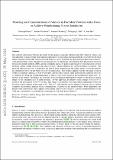Modeling and characterization of cohesion in fine metal powders with a focus on additive manufacturing process simulations
Author(s)
Meier, C; Weissbach, R; Weinberg, J; Wall, WA; John Hart, A
DownloadAccepted version (4.518Mb)
Publisher with Creative Commons License
Publisher with Creative Commons License
Creative Commons Attribution
Terms of use
Metadata
Show full item recordAbstract
© 2018 Elsevier B.V. The cohesive interactions between fine metal powder particles crucially influence their flow behavior, which is important to many powder-based manufacturing processes including metal additive manufacturing (AM). The present work proposes a novel modeling and characterization approach for micron-scale metal powders, with a focus on characteristics of importance to powder bed AM. The model is based on the discrete element method (DEM), and the considered particle-to-particle and particle-to-wall interactions involve frictional contact, rolling resistance and cohesive forces. Special emphasis lies on the modeling of cohesion. The proposed adhesion force law is defined by the pull-off force resulting from the surface energy of powder particles in combination with a van-der-Waals force curve regularization. The model is applied to predict the angle of repose (AOR) of exemplary spherical Ti-6Al-4 V powders, and the surface energy value underlying the adhesion force law is calibrated by fitting the corresponding angle of repose values from numerical and experimental funnel tests. To the best of the authors’ knowledge, this is the first work providing an experimental estimate for the effective surface energy of the considered class of metal powders. By this approach, an effective surface energy of 0.1mJ/m2 is found for the investigated Ti-6Al-4 V powder. This value is considerably lower than typical experimental values for flat metal contact surfaces, which range from 30 − 50mJ/m2. Thus, factors such as surface roughness, surface chemistry and potential surface oxidation have crucial influence on bulk power behavior. Moreover, the present study demonstrates that a neglect of the related cohesive forces leads to a drastical underestimation of the AOR and, consequently, to an insufficient representation of the bulk powder behavior.
Date issued
2019-02-01Department
Massachusetts Institute of Technology. Department of Mechanical Engineering; Lincoln LaboratoryJournal
Powder Technology
Publisher
Elsevier BV